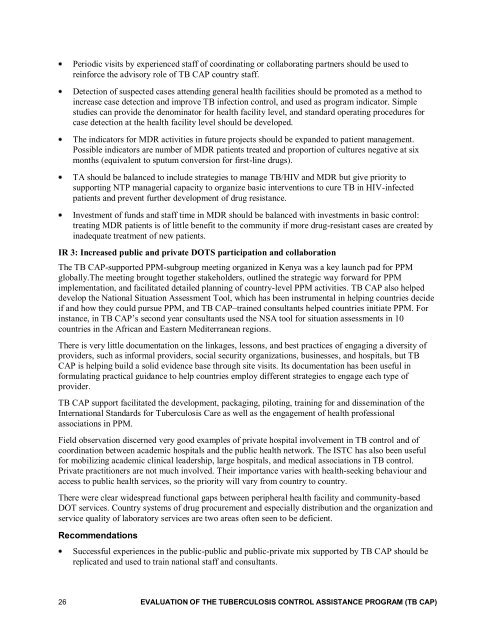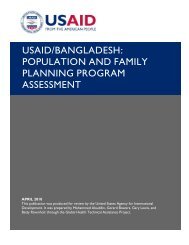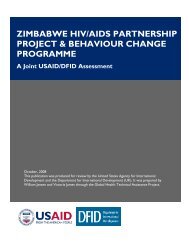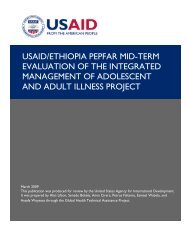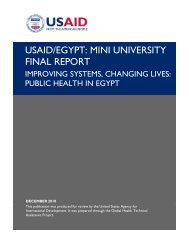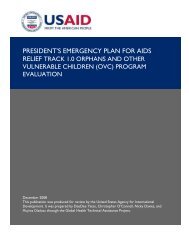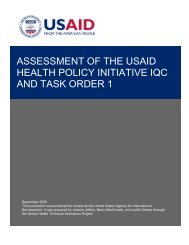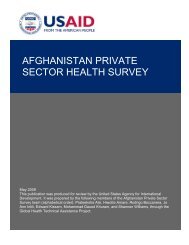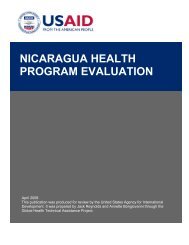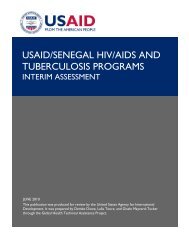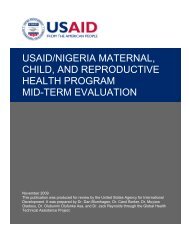Evaluation of the Tuberculosis Control Assistance Program (TB CAP)
Evaluation of the Tuberculosis Control Assistance Program (TB CAP)
Evaluation of the Tuberculosis Control Assistance Program (TB CAP)
You also want an ePaper? Increase the reach of your titles
YUMPU automatically turns print PDFs into web optimized ePapers that Google loves.
Periodic visits by experienced staff <strong>of</strong> coordinating or collaborating partners should be used toreinforce <strong>the</strong> advisory role <strong>of</strong> <strong>TB</strong> <strong>CAP</strong> country staff.Detection <strong>of</strong> suspected cases attending general health facilities should be promoted as a method toincrease case detection and improve <strong>TB</strong> infection control, and used as program indicator. Simplestudies can provide <strong>the</strong> denominator for health facility level, and standard operating procedures forcase detection at <strong>the</strong> health facility level should be developed.The indicators for MDR activities in future projects should be expanded to patient management.Possible indicators are number <strong>of</strong> MDR patients treated and proportion <strong>of</strong> cultures negative at sixmonths (equivalent to sputum conversion for first-line drugs).TA should be balanced to include strategies to manage <strong>TB</strong>/HIV and MDR but give priority tosupporting NTP managerial capacity to organize basic interventions to cure <strong>TB</strong> in HIV-infectedpatients and prevent fur<strong>the</strong>r development <strong>of</strong> drug resistance.Investment <strong>of</strong> funds and staff time in MDR should be balanced with investments in basic control:treating MDR patients is <strong>of</strong> little benefit to <strong>the</strong> community if more drug-resistant cases are created byinadequate treatment <strong>of</strong> new patients.IR 3: Increased public and private DOTS participation and collaborationThe <strong>TB</strong> <strong>CAP</strong>-supported PPM-subgroup meeting organized in Kenya was a key launch pad for PPMglobally.The meeting brought toge<strong>the</strong>r stakeholders, outlined <strong>the</strong> strategic way forward for PPMimplementation, and facilitated detailed planning <strong>of</strong> country-level PPM activities. <strong>TB</strong> <strong>CAP</strong> also helpeddevelop <strong>the</strong> National Situation Assessment Tool, which has been instrumental in helping countries decideif and how <strong>the</strong>y could pursue PPM, and <strong>TB</strong> <strong>CAP</strong>–trained consultants helped countries initiate PPM. Forinstance, in <strong>TB</strong> <strong>CAP</strong>’s second year consultants used <strong>the</strong> NSA tool for situation assessments in 10countries in <strong>the</strong> African and Eastern Mediterranean regions.There is very little documentation on <strong>the</strong> linkages, lessons, and best practices <strong>of</strong> engaging a diversity <strong>of</strong>providers, such as informal providers, social security organizations, businesses, and hospitals, but <strong>TB</strong><strong>CAP</strong> is helping build a solid evidence base through site visits. Its documentation has been useful informulating practical guidance to help countries employ different strategies to engage each type <strong>of</strong>provider.<strong>TB</strong> <strong>CAP</strong> support facilitated <strong>the</strong> development, packaging, piloting, training for and dissemination <strong>of</strong> <strong>the</strong>International Standards for <strong>Tuberculosis</strong> Care as well as <strong>the</strong> engagement <strong>of</strong> health pr<strong>of</strong>essionalassociations in PPM.Field observation discerned very good examples <strong>of</strong> private hospital involvement in <strong>TB</strong> control and <strong>of</strong>coordination between academic hospitals and <strong>the</strong> public health network. The ISTC has also been usefulfor mobilizing academic clinical leadership, large hospitals, and medical associations in <strong>TB</strong> control.Private practitioners are not much involved. Their importance varies with health-seeking behaviour andaccess to public health services, so <strong>the</strong> priority will vary from country to country.There were clear widespread functional gaps between peripheral health facility and community-basedDOT services. Country systems <strong>of</strong> drug procurement and especially distribution and <strong>the</strong> organization andservice quality <strong>of</strong> laboratory services are two areas <strong>of</strong>ten seen to be deficient.RecommendationsSuccessful experiences in <strong>the</strong> public-public and public-private mix supported by <strong>TB</strong> <strong>CAP</strong> should bereplicated and used to train national staff and consultants.26 EVALUATION OF THE TUBERCULOSIS CONTROL ASSISTANCE PROGRAM (<strong>TB</strong> <strong>CAP</strong>)


